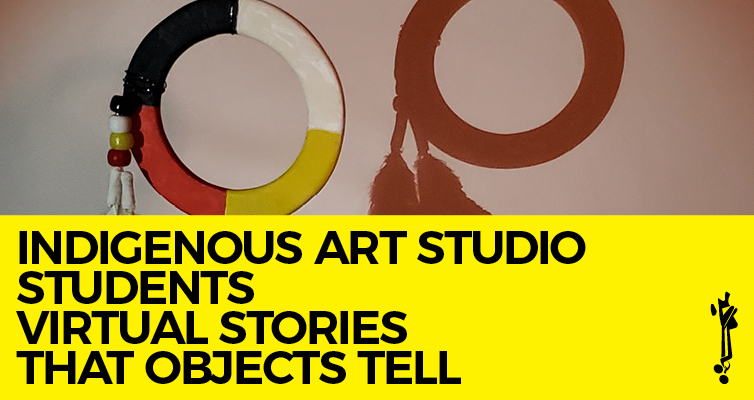Online Exhibition
Virtual Stories That Objects Tell
December 18, 2020
Exhibition Page Gallery View
An online exhibition of artwork by ULethbridge students in Indigenous Art Studio (Fall 2020) made in response to Mootookakio’ssin.
Stories That Object Tell
An online exhibition of artwork by uLethbridge students in Indigenous Art Studio (Fall 2020) made in response to Mootookakio’ssin – a project to create detailed digital images of historical Blackfoot objects housed in British museums.
When the Mootookakio’ssin team started this project, we never conceived of working entirely by virtual means. The goal of the project was to make historical Blackfoot objects held in museums in Britain accessible to people in Blackfoot territory. We were focused on how people could connect with the digital images, and exhibitions were central to our strategy to make these in-person connections. We planned to feature artworks made in response to the digital images, to the techniques and knowledge that can be learnt from the historic Blackfoot objects, and to the research generated around the colonial history of these objects. The lockdown in response to COVID-19 dramatically changed our approach. As a result, Stories That Objects Tell is the first exhibition that the uLethbridge Art Gallery and the Mootookakio’ssin team has created by virtual means and have produced to be only an online exhibition.
Mootookakio’ssin is a Blackfoot word that means ‘distant awareness’ and this name took on an additional dimension for the students enrolled in the Fall, 2020 version of Dr. Jackson 2Bears’ Indigenous Art Studio class. With the University of Lethbridge campus closed, the class occurred entirely online. The students had to make their work from home and they had to make work that either exists purely in a digital format or that would work well when documented and presented online. Jackson and Miguelzinta Solis, a PhD student and Jackson’s research assistant, provided superb guidance and support. The students were nothing short of amazing in how they stepped up to this challenge and created ambitious, insightful, and emotional works that engage with identity, personal history, the legacies of colonialism, and museum practices.
The precautions in response to the COVID-19 pandemic forced us to use only virtual means of communication and to conceive of this exhibition from start to finish in digital formats. Together, students, gallery staff, and the research team explored possibilities and experimented with imagery and ideas. I am so grateful for the generosity and hard work from all involved with this project. I would also like to thank recent graduate Calvin Lloyd who expertly created the micro website for this exhibition.
Josephine Mills
Director/Curator
About Mootookakio’ssin:
Mootookakio’ssin aims to connect people living on traditional Blackfoot territory (Southern Alberta, Canada) with non-sacred, historical Blackfoot objects housed in museum collections in Britain and uses digital imagery to record objects in great detail. The project’s title, Mootookakio’ssin, was given by Elder Leroy Little Bear and translates to “distant awareness.” Elders from the four Blackfoot tribes, Kainai, Piikani, Siksika, and Amskapipiikani, are directing the project and selecting the museum objects. The digital imagery belongs to the Blackfoot people and will be accessible on-line through the Blackfoot Digital Library at the U of L. The Mootookakio’ssin project is only making images of non-sacred objects available to the public. The project is funded by a grant from the New Frontiers in Research Fund, administered by the Social Sciences and Humanities Research Council of Canada. Christine Clark, from the uLethbridge Department of New Media is the Principal Investigator for the grant, and is leading the development of a micro website that presents the digital images and their associated knowledge. The website is currently in process, but you can visit it for further information: Mootookakio’ssin.

